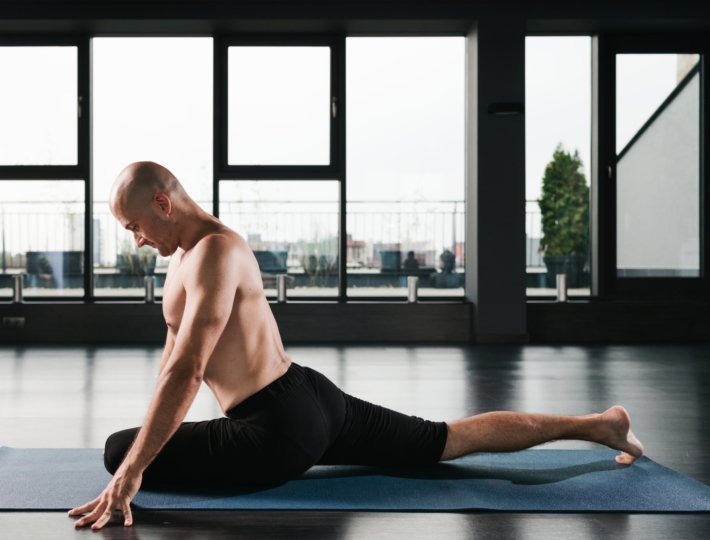Life is pain, Highness. Anyone who says differently is selling something. – The Princess Bride
The inevitability of pain isn’t just true for life but also for exercise. Anyone who claims the opposite is probably hawking a workout DVD or a meal-replacement shake. The fact is, exercise inherently requires physical effort, and physical effort can be uncomfortable. We all know that this sweaty, sometimes painful activity packs important health benefits and can make you feel surprisingly good, even while your lungs are burning and your legs are shaking in a cry for surrender. But psychologically we are wired to avoid discomfort, which is one reason why finding the willpower to exercise can be so hard.
So how do we get past the (totally understandable) urge to skip the gym and go straight to the warm embrace of sweatpants? It seems that the key might be a matter of minimizing the psychological toll that bodily stress takes on our motivation.
One way to do this is to reduce physical exertion. It’s not often in the fitness world that you’re told to do less, and that’s a shame, because putting in a little bit of effort in the time you have is the most realistic option for most people, and doing something is always better than doing nothing. So give yourself permission to take it easy. If you don’t want to run, walk. If your muscles are tired, put down the weights. Also, never underestimate the value of a short workout. A review of research published in 2011 by Kelly McGonigal, Ph.D., a health psychologist at Stanford, concluded that short sessions of just 5 to 15 minutes of exercise a day can have major long-term benefits on health.
Another approach is to take the “work” out of your workout and inject more enjoyment instead. There are plenty of ways to do this, such as participating in group activities that tap your competitive nature or doing play-based routines that make physical movement fun. In fact, a 2014 Cornell study found that people who perceived their workout to be fun made healthier food choices, stuck with their program longer, and felt better afterward, compared to people who did the exact same workout and perceived it to be hard. Attitude goes a long way.
However, there’s also another option that’s equally viable and totally transformative: Learn how to become comfortable with discomfort. It may sound like a yogic cliché, but developing the ability to be steadfast in the face of stress has the power to unlock a world of benefits for your physical fitness and your life.
Despite what we’ve been taught to believe, stress itself isn’t bad, explains McGonigal in her TED talk “How To Make Stress Your Friend.” For years we’ve been told that stress is the ultimate enemy, but we can’t grow without it. “The new science of stress reveals that how you think about stress matters,” she says. We don’t want to get rid of stress; we want to get better at stress.”
This idea applies to fitness, too. At a basic level, being able to tolerate some stress during exercise is essential to the activity and for its desired outcomes. “For muscle strength to increase, the muscle must see some increase in stress, usually perceived as ‘the burn,’ and this mild burn is what we call ‘good pain’,” explains Andrew Cosgarea, M.D., co-director of the orthopedics department of Johns Hopkins Medicine in Baltimore.
Figuring out how much physical stress is appropriate during a workout is a process in itself. The standard exercise guidelines for good health suggest adults move at a moderate intensity (or 65 percent to 75 percent max heart rate) for 150 minutes a week or at an aerobic intensity (76 percent to 90 percent max heart rate) for 75 minutes per week. This seems straightforward, but a recent study found that sedentary adults tend to underestimate how hard they should exert themselves to meet these guidelines and overestimate how vigorously they are working out during exercise. Basically, even if you think you’re killing it during that cycling class, your perception of the amount of work your body is doing at low levels of discomfort is likely skewed. Often what we assume is sufficient for results and optimal health probably falls short.
On the other end of the spectrum, you don’t want to ignore your body’s cries for attention. Muscles, tendons, ligaments, cartilage, and bones are living structures that react to the stress of exercise very slowly, Cosgarea explains. “If they see stress too fast or too much stress over time, they begin to fail,” he says. “Each one of these tissues responds a little differently and begins to produce what we call ‘bad pain.'” The key with “good pain,” he says, is that it should last only as long as you are doing the activity.
You know you’ve hit the sweet spot when you feel fatigued and exhilarated after your workout but not totally exhausted. It’s good to feel a little soreness, but if your muscles are painful to move or touch for days afterward (what’s known as delayed onset muscle soreness, or DOMS), you’ve damaged the muscle too much and need to scale back. Tendonitis, stress fractures, swelling, weakness, tingling or numbness, pain that does not go away with rest or is increasing, and pain that wakes you up from sleep are all your body’s way of telling you to cool it.
So how can you shift your perspective on discomfort so you’re able to productively challenge yourself without sacrificing your health or happiness?
Meditation can be a useful tool. One of the greatest skills meditation cultivates is the ability to separate one’s self from the experience and observe it. This is a central tenet of the Mindfulness-Based Stress Reduction (MBSR) technique, and in practice it can help lower the cognitive stress of physical discomfort. “It’s not a matter of letting go—you would if you could,” writes Jon Kabat-Zinn, professor of medicine emeritus at the University of Massachusetts Medical School and creator of MBSR. “Instead of ‘let it go’ we should probably say ‘let it be’.”
Yoga is another mechanism to help you exercise patient awareness, and even joyous acceptance, of physical challenge. The practice of holding steady in a posture while the body’s muscles are ignited by effort offers a glimpse at your typical reaction to discomfort. Simultaneously, yoga also provides a safe environment where one can observe the body’s true range of motion and begin to better understand its physical limitations.
As you become more at ease practicing the gentle dance with discomfort, a funny thing might happen—you’ll become more resilient than ever before. A recent study found that while exercise didn’t increase a person’s pain threshold (the point at which one starts to feel pain) it did substantially increase one’s ability to tolerate the pain longer. But take care to scale up your efforts slowly, especially if you are just beginning a new program or are returning to exercise after an extended break. Cosagarea recommends you gradually increase intensity rather than time, as the more time you spend stressing your muscles and joints the more likely you are to get injured.
You can also mindfully challenge yourself through a focus on mechanics and form. “Sometimes it’s not a matter of pushing harder, but rather, knowing better and working smarter,” says Kylie Larson, a yoga teacher and group fitness instructor. For instance, just the small change of making sure the tops of your thighs are parallel to the ground when you do chair pose can take your workout from “meh” to “mercy!” You may want to enlist the help of a good teacher—or at least a mirror—to check and refine your form and movement patterns.
As you improve your ability to sit with discomfort, you’ll eventually experience much broader benefits than just a deeper squat and improved fitness—it will open up a host of other possibilities in life. As Leo Babauto, founder of the blog Zen Habits, points out, you’ll have the tools to be more productive, stay organized, wake up earlier, make more nutritious food choices, improve your finances, and do other things that require stepping outside your comfort zone. When you’re able to tackle discomfort head on, you ultimately free yourself from the fear of challenge and can achieve things you never thought possible.











Comments (2)